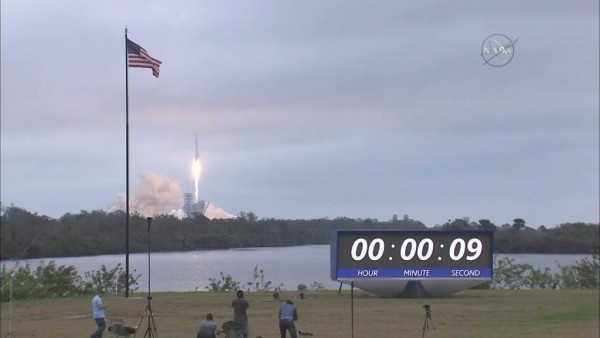By Ana Verayo, | February 20, 2017

The SpaceX Dragon lifts off atop a Falcon 9 rocket from Kennedy Space Center in Florida. (NASA TV)
SpaceX has launched its first private rocket on the very same launch pad that witnessed some of NASA's historic space missions. The company's reusable Falcon 9 rocket then successfully landed on a floating drone ship off the coast of Florida.
On Sunday, February 19, the private aerospace company based in Hawthorne, California launched its Dragon cargo capsule for a resupply mission to the International Space Station. The Falcon 9 rocket carrying the Dragon capsule blasted off from the Launch Complex 39A at NASA's Kennedy Space Center where the Apollo moon missions and space shuttle launches also took off. The launch was initially scheduled for Saturday but was scrubbed off some 13 seconds before liftoff when mission scientists detected an unexpected reading from the rocket's second stage.
Like Us on Facebook
Sunday's launch did not bode too well at first as the rocket's first stage returned back to Earth successfully yet landed a few miles from the Florida launch site, at eight minutes after liftoff. Apart from this, this SpaceX launch marks the first daytime landing at the launch pad which is now known as Landing Zone 1, at the Cape Canaveral Air Force Station.
The Falcon 9's booster rocket separated into its first and second stages within 2.5 minutes after blast off. The first stage rocket flew back for a successful touchdown and the second stage of the rocket continued to fly into lower Earth orbit carrying the Dragon capsule. The cargo vehicle safely entered into space 11 minutes after liftoff where it also successfully launched its solar arrays. It will arrive at the space station in two days.
The Dragon capsule will arrive on the morning of Tuesday, February 21 as European Space Agency's astronaut Thomas Pesquet will capture the cargo vehicle with a robotic arm called Canadarm 2. He will be assisted by space station commander, NASA's Shane Kimbrough. NASA astronaut Peggy Whitson will monitor the capsule's approach, and once Dragon is grabbed by the robotic arm, mission ground control will guide the Dragon to the space station.
Cargo supply missions to the ISS are crucial since they carry supplies, tools, and scientific equipment for experiments aboard the space lab. This particular cargo vehicle is filled with research and hardware that was collected by 800 scientists from around the world.
The Dragon capsule is packed with almost 5,500 pounds of cargo. It will return to Earth after 29 days docking, carrying back almost 5,000 pounds. Inside the unpressurized cargo spacecraft are scientific tools like the SAGE-II which can monitor the planet's ozone and a Space Test Program payload with the Lightning Imaging Sensor to track lightning events all over Earth. The Raven is a special instrument that can collect data and help other spacecraft for easier autonomous rendezvous.
These experiments will be removed on the second day when the Dragon capsule is docked, and they will be installed at the space station using robotic arm attachments. This is a very complex and tedious mission that can last for 15 days straight. Payloads no longer used will return to Earth inside the Dragon's trunk.
Meanwhile, inside the pressurized trunk of the Dragon capsule are 1,600 pounds of scientific tests. These include the MRSA bacteria or "superbug" that can adapt in space, a stem cell growing experiment, antibody crystallization experiment, and a mouse study that will investigate how wounds heal in space, along with many student experiments.
-
Use of Coronavirus Pandemic Drones Raises Privacy Concerns: Drones Spread Fear, Local Officials Say

-
Coronavirus Hampers The Delivery Of Lockheed Martin F-35 Stealth Fighters For 2020

-
Instagram Speeds Up Plans to Add Account Memorialization Feature Due to COVID-19 Deaths

-
NASA: Perseverance Plans to Bring 'Mars Rock' to Earth in 2031

-
600 Dead And 3,000 In The Hospital as Iranians Believed Drinking High-Concentrations of Alcohol Can Cure The Coronavirus

-
600 Dead And 3,000 In The Hospital as Iranians Believed Drinking High-Concentrations of Alcohol Can Cure The Coronavirus

-
COVID-19: Doctors, Nurses Use Virtual Reality to Learn New Skills in Treating Coronavirus Patients







